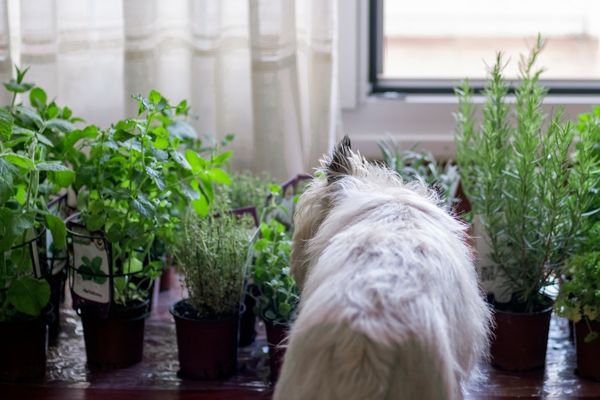Nutrition is a vital aspect of dog parenting. When fed the right balance of food, your pooch will be able to perform daily activities, build and repair cells, fight diseases, and so much more. Aside from giving your pet specially formulated meals for his particular life stage or health condition, you can occasionally give him human food as treats. However, it’s important to know that not all edible ingredients for people are safe for pets. Herbs and spices are especially tricky since some of these seasonings are toxic for dogs and cats.
Whether you’re caring for a newly adopted dog or have been fostering pups for some time, these feeding tips will help you figure out which human foods with a bit of seasoning can fit in with their food routine. Stay tuned to learn about:
- What do dogs need to thrive?
- What exactly are herbs and spices?
- Which herbs can dogs eat?
- Which spices can dogs eat?
- How should you feed a dog herbs and spices for the first time?
Please note that this Waldo’s Friends article must not replace a one-on-one consultation with your veterinarian or pet nutritionist. It is only meant to be used as a reference guide. Your doctor can give a more detailed analysis of what your dog needs. This may be based on various factors such as your dog’s size, age, weight, activity levels, and existing medical or behavioural conditions.
What do dogs need to thrive?
Protein, fat, carbohydrates, vitamins, minerals, and water all work together to support your dog’s health and energy levels. Protein, in particular, helps with the growth, formation, and maintenance of his musculoskeletal system. The digested protein turns into amino acids that nourish and sustain his different organs.
Dogs need about 18 to 22% of dietary protein or dry matter (DM). Anything over 30% DM will not benefit him. Since meat is a great source of amino acids, many dog food options contain animal-derived protein. It may be a challenge for dogs to go on a strictly vegan diet, but it can be accomplished with the close supervision of a veterinarian or a pet nutritionist.
When fed incorrectly, dogs can develop health problems such as diarrhea, obesity, bladder stones, heart disease, and pancreatitis. Therefore, you should always follow your doctor’s serving recommendations and provide dog food from premium sources.
What exactly are herbs and spices?
Herb and spices both come from plants. Herbs are categorised under vegetables, with their flowers, leaves, and stems utilised in fresh or dried forms. Similar to herbs, spices are used to flavour food. But more than just their flowers, stems, and leaves, the plant’s bark, fruits, roots, and seeds can also be used. These can also be eaten raw or consumed in dried and powdered forms.
As omnivores, dogs can derive nutrients from both animal and plant sources. But because of potentially toxic compounds found in certain produce, you should not feed your pooch anything new without checking with your vet. Avoid risks by reviewing the list of toxic and non-toxic plants created by the American Society for the Prevention of Cruelty to Animals. Remember that even if something is listed as non-toxic, overconsumption of plant-based matter can lead to digestive issues.

Which herbs can dogs eat?
Basil
From reducing anxiety to preventing cellular damage, basil is considered beneficial for dogs. The herb can be given either raw or dried.
Chives
Never give your dog chives as it may result in internal organ damage. Gastroenteritis and hemolytic anemia are just two examples of what he can get days after eating this herb.
Cilantro
The seeds and leaves of cilantro can be given to dogs in moderation. These can help improve his skin, support his immune system, and assist with his digestion.
Dill
Also considered a spice, dill is non-toxic for canine and feline pets. Your dog can eat this herb to support his various systems, from gastrointestinal to circulatory.
Lemongrass
Lemongrass contains cyanogenic glycosides and essential oils unsafe for canines. Eating the plant can cause upset stomach or intestinal blockage. Meanwhile, the essential oil can bring about skin irritation.
Licorice
This medicinal herb should only be given in limited amounts with your vet’s consent. However, dogs should only eat licorice root and not licorice-flavoured candy.
Mint
Not all mint varieties are safe for dogs to eat. Take note of canine-safe ones, which include mint, spearmint, peppermint, and catmint.
Parsley
Only curly parsley is harmless for dogs. Other types are toxic and can lead to photosensitisation.
Rosemary
A non-toxic plant, rosemary can be given to your pooch in fresh or dried forms. Plus, it can also work as a natural flea repellant and coat conditioner.
Thyme
You can serve small quantities of thyme to your dog. The plant can help improve his respiratory and gastrointestinal systems.

Which spices can dogs eat?
Black pepper
Whole peppercorn as well as ground black pepper should not be given to pooches. Consumption may lead to respiratory and gastrointestinal issues.
Celery
More than just being a nutritious vegetable, the seeds of celery are also used as a spice. These can help reduce blood pressure and bad cholesterol in canines.
Cinnamon
Cinnamon is a fragrant, brown-coloured spice that doesn’t need to be included in your pet’s meals. When eaten, it may cause irritations in his gastrointestinal and respiratory systems.
Fennel
A sweet smelling spice, fennel is also used as an herb and eaten as a vegetable. The plant is non-toxic for dogs, so it can be fed to him in moderate amounts. It can function as a breath freshener and assist in your dog’s digestion and immunity.
Garlic
A popular ingredient belonging to the allium genus, garlic is highly poisonous to dogs. Whether in raw, cooked, or powdered form, it should never be given to your pets.
Ginger
Dogs can only consume limited quantities of ginger. It has countless benefits from preventing gastric bloating to enhancing stomach motility.
Mustard
A yellowish condiment, mustard comes from the plant of the same name. Its seeds are actually harmful for canines. When eaten by your dog, he can experience abdominal pain, diarrhea, and vomiting.
Nutmeg
Keep this fragrant spice away from your pooch. Nutmeg contains the natural compound myristicin, which can cause gastrointestinal and respiratory complications.
Onion
Similar to garlic, onions are packed with sulfoxides and disulfides that are very harmful for dogs. Refrain from giving him raw, cooked, or powdered onions. Also, any dish that contains onions should never be served to your canine pet.
Oregano
Avoid giving your dog oregano as the spice contains gastrointestinal irritants. Moreover, it can cause slow or decreased heart rate, bruising, and bleeding.
Turmeric
Turmeric is a flowering plant that belongs to the ginger family. When given correctly, the bright-coloured spice can prevent arthritis, cancer, and diabetes in dogs.

How should you feed a dog herbs and spices for the first time?
Err on the side of caution. Refrain from giving your canine anything found in your spice rack. Similarly, limit his access to herbs that you may be growing indoors or in your backyard.
TIP: Create a sensory garden for your pooch using canine-safe plants and materials.
When giving a particular herb or spice for the first time, allow your dog to sniff it and acquaint himself with it. Let him try a very small amount, and observe his body’s reactions to it over the next 24 hours. Unless needed, do not force your pet to eat it as some herbs and spices have strong scents that may repel him.
Do not give your pet fresh herbs from seasoned meat. These may have been exposed to other harmful ingredients such as onions and garlic that can instantly harm them. Likewise, stay away from seasoning mixes that contain salt, sugar, preservatives, and other potentially dangerous ingredients.
Learn more about the proper way to feed your dog by perusing our “can dogs eat” category. Discover which beans, legumes, fruits, and vegetables your canine pet can safely have. Plus, read our food guides to discover the best food to serve puppies and eldery dogs. Cat paw-rents can also browse through our “can cats eat” category for feline feeding tips and tricks.
Leave a comment
Your email address will not be published. All fields are required.